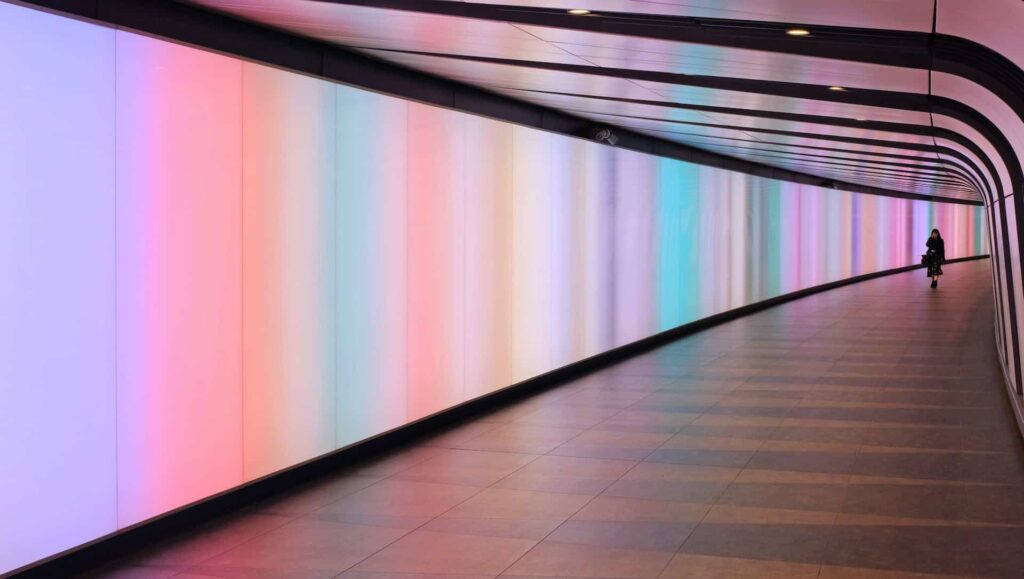There’s a new way to get your business noticed. Transparent LED screens and displays are the latest trends in advertising and marketing, and they’re a great way to show off your products or services. These screens can be used indoors or outdoors and come in all shapes and sizes. Read on to see if transparent LED screens are suitable for you.
Considering LED Signs
If LED digital signage is something you’re thinking about for your company or organization, you might be surprised at the alternatives available. They have advanced significantly from the standard rectangular flatscreens inside and outside stores, malls, transportation hubs, and other public areas where many people congregate. Transparent displays, or panels with vivid visuals that enable you to see through them, are one of the various technologies chosen. Usually mounted behind glass to provide a striking facade with brilliant content viewable from a distance, they range in transparency from 70 to 95 percent.
Compared to Conventional Displays
Transparent LEDs play any material, including photographs and videos, just as conventional displays. Transparent LED displays do not obstruct light, in contrast to standard LED displays and traditional static signage, so when they are used in storefront windows, clients can see from within the store to the outside and vice versa, creating an eye-catching advertising environment.
While static billboards have been criticized for impeding countryside views, classic LED displays have dazzled onlookers for years. Due to their awareness of these difficulties, city planners have implemented stronger regulations for their use. However, the introduction of transparent LED displays aids in resolving that difficulty and enhancing cities’ aesthetic appeal. They allow for the transmission of natural light and the delivery of dynamic, captivating content.
Another great thing about transparent LED screens is that they can be customized to meet your specific needs. Whether you want a small screen that fits in the window of your storefront or a massive screen that takes up an entire wall, there’s a transparent LED screen out there that’s perfect for you. And because they’re so easy to transport and install, you can change your marketing strategy on the fly if you need to—something impossible with traditional billboards or other outdoor advertising.
Transparent LED lights are a terrific complement to well-liked high-end commercial developments. They have been gaining popularity in cities worldwide due to their ultra-thin design, absence of steel, ease of installation and maintenance, and high transparency.
Related Link: 8 Benefits of Smart Boards
How Do Transparent LED Screens Work?
However, how do they work? Transmissive materials can be made opaque without the need of energy by using an array of organic LEDs (OLEDs) or Light Emitting Diodes (LEDs). When there is no power supply, full transparency is still possible since light can travel through unhindered.
Wanting to stay up to date with workplace technology? Visit our blog today!

Average Price Range of Transparent LED Screens
Transparent LED screens are becoming more and more popular. But how much do they cost? The answer, unfortunately, is not a simple one. The price of a transparent LED screen depends on a number of factors, including the size of the screen, the type of LEDs used, the overall quality of the screen, and more. In this blog post, we’ll break down some of the main factors that affect the cost of a transparent LED screen. Hopefully, this will give you a better idea of what to expect when budgeting for your own transparent LED screen.
Size
Probably the most important factor affecting the price of a transparent LED screen is size. Larger screens will obviously cost more than smaller ones. However, it’s important to keep in mind that the price doesn’t always scale linearly with size. That is, a 10×10 foot LED screen will not necessarily cost twice as much as a 5×5 foot screen. This is because larger screens often have to be custom-made, which can drive up the price. In general, you can expect to pay anywhere from $500 for a small (2×2 foot)LED screen to $5000 or more for a large (20×20 foot) one.
Related Link: How Life-Safety Systems & Technology Keep Students Safe
Type of LEDs Used
Not all LEDs are created equal. High-quality LEDs will usually cost more than lower-quality ones. For example, you might pay $2000 for an LED screen made with mid-range LEDs, or $4000 for one made with high-end LEDs. While this might seem like a big difference, it’s important to remember that LEDs are designed to last for years—sometimes even decades—so you’ll probably end up saving money in the long run by investing in a higher-quality product up front.
Quality
In addition to the type of LED used, the overall quality of the transparent LED screen itself can affect its price. For instance, a well-made transparent LED screen from a reputable manufacturer is likely to cost more than a cheaply made one from an unknown brand.
Looking for help with implementing workplace technology for your business? Contact us to get assistance today!
Using Transparent LED Screens
Transparent LED screens are becoming increasingly popular thanks to their eye-catching visuals and versatile applications. The benefits of using transparent LED screens are numerous. Thanks to their transparency, they can be used in a wide range of locations that would not be possible with traditional signage. Transparent LED screens can also be very eye-catching, helping your business stand out from the competition. And because they use LEDs, they are very energy-efficient, which means they will save you money on your energy bills. If you are looking for a new and exciting way to promote your business, then transparent LED screens are definitely worth considering.
Related Link: 21:9 Ultrawide Monitors: The Future of Video Conferencing
Last Updated on January 20, 2023 by Josh Mahan




